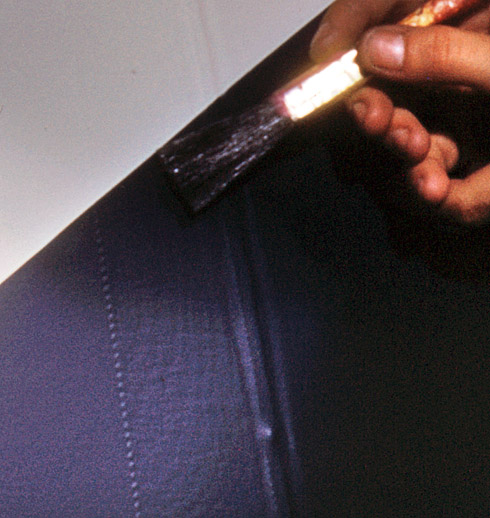


Framed or unframed, desk size to sofa size, printed by us in Arizona and Alabama since 2007. Explore now.
Shorpy is funded by you. Patreon contributors get an ad-free experience.
Learn more.

- Baldwin 62303
- Baldwin VO-1000
- Cold
- No expense spared
- Tough Guys
- Lost in Toyland
- And without gloves
- If I were a blindfolded time traveler
- Smoke Consumer Also Cooks
- Oh that stove!
- Possibly still there?
- What?!?
- $100 Reward
- Freeze Frame
- Texas Flyer wanted
- Just a Year Too Soon
- WWII -- Replacing men with women at the railroad crossing.
- Yes, Icing
- You kids drive me nuts!
- NOT An Easy Job
- I wonder
- Just add window boxes
- Icing Platform?
- Indiana Harbor Belt abides
- Freezing haze
- Corrections (for those who care)
- C&NW at Nelson
- Fallen Flags
- A dangerous job made worse
- Water Stop
Print Emporium
Art Star: 1943

Touching up the U.S. Army Air Forces insignia on a "Vengeance" dive bomber manufactured at Consolidated-Vultee's Nashville division. February 1943. View full size. 4x5 Kodachrome transparency by Alfred Palmer.
Vultee Vigilant
That actually looks like it might be the fabric covered wing of a Vultee L-1 Vigilant. You can see the rib tapes and the metal leading edge and slat. The Vengance had metal wings.

Vengeance
This looks like the wing of the aircraft instead of the side. Carrier planes had folding wings.
[Could be. But the photographer's caption says "insignia on the side of the fuselage." - Dave]

Aircraft Insignia
The subject of official aircraft insignia is somewhat complex. There are actually two different "rules" about insignia, one of which is no longer followed. However, at the time of this photo, the US Civilian Insignia was still this symbol while the US Military Insignia dropped the red ball so that there would be no confusion with Japanese markings. I assume these planes were considered "civilian" aircraft until the military took possession, hence the discrepancy in the marking. I cannot find that the US Civilian Insignia was ever changed (the military insignia was changed several times during WWII), but in 1947 it was made optional and no one uses it today.
Curious then...
because I checked the Naval Historical Center's page and they show that the insignia was changed to just a white star in May of '42.
http://www.history.navy.mil/faqs/faq2-1.htm
[Someone should show her that Web page. - Dave]
I wonder about
The date of the photo.
I was under the impression that the "meatball" insignia (red ball in the white star) was dropped by US forces sometime in 1942.
[This is one of 293 photographs in the Library of Congress archives taken by Alfred Palmer on his visit to the Consolidated-Vultee factory in Nashville in February 1943. - Dave]
























On Shorpy:
Today’s Top 5